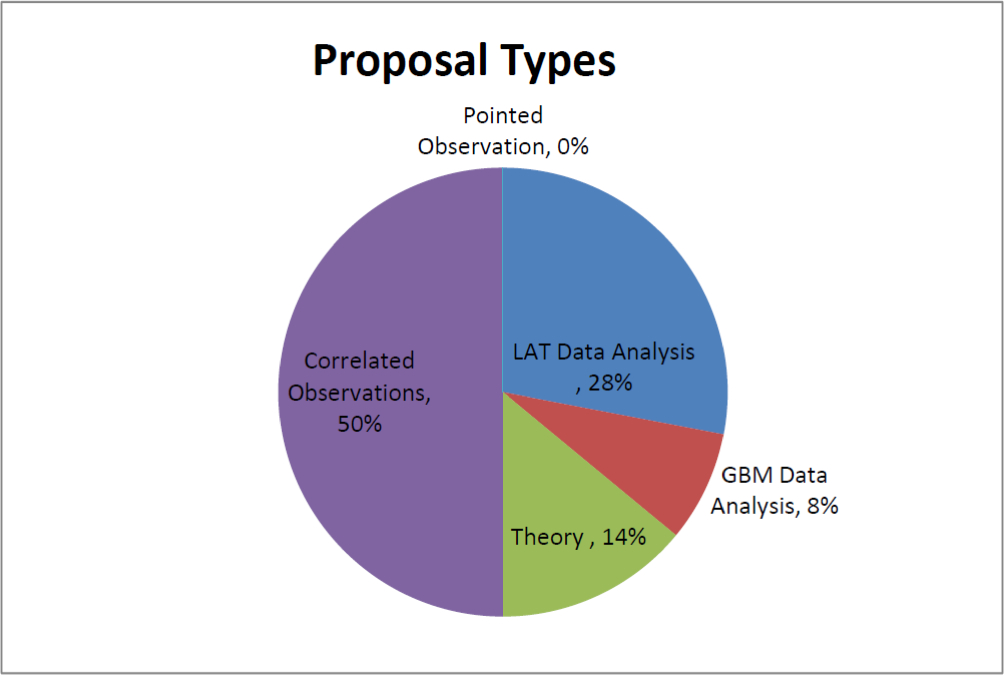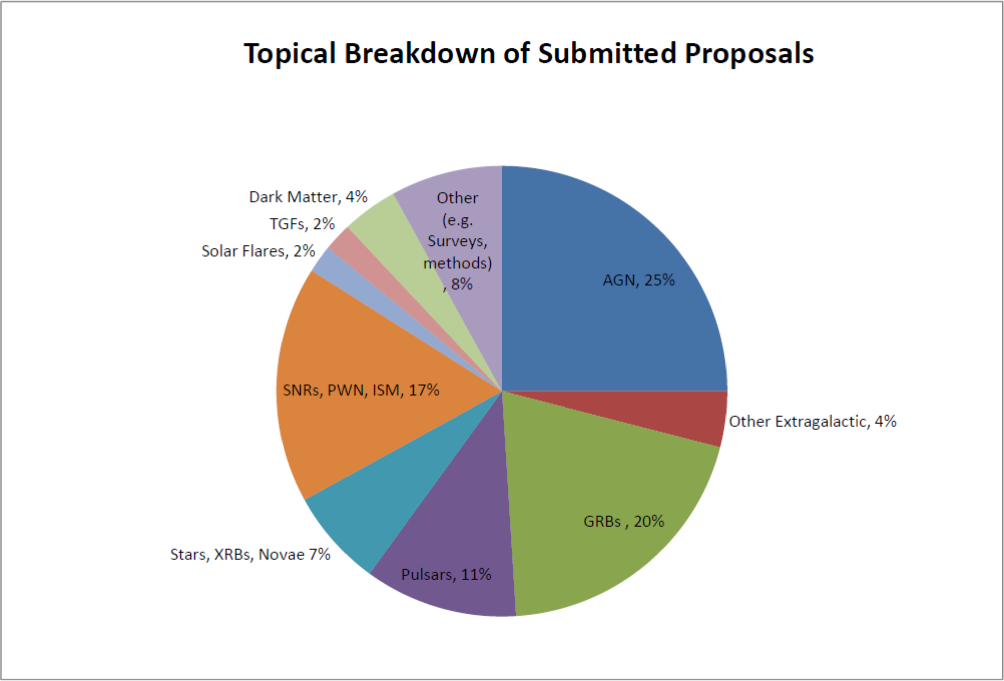Fermi Cycle 7 Guest Investigator Program Summary
The call for Fermi GI proposals is issued annually as part of the NASA ROSES NRA and details are in Appendix D.6 of that document. Typically, proposals are due in the January/February timeframe and each new mission cycle starts in mid August. Since Fermi proposals are predominantly requests for grant support - all Fermi science data products are publicly available promptly following acquisition - the proposal PIs are almost exclusively from US institutions. Nonetheless, a large number of non-US co-Is participate in the program including more than 50 for Cycle 7.
Proposals to participate in the Fermi Cycle-7 GI program were due on January 31, 2014. A total of 224 proposals were received, involving 230 institutions and 922 individual investigators (PIs and co-Is). These proposals were evaluated through a two stage process. A scientific peer-review was organized and it took place in late April 2014. A total of 52 scientists from 36 institutions participated. That led to 44 selections and thus an overall selection rate of 20%. A second stage review, in which details of funding requests from those selected in the stage-I review, was held in July. The results of this review process and some historical perspective are summarized below
The number of proposals submitted has remained fairly flat since Cycle 4, but the number of selections has declined by nearly 50% (see figure, "Fermi GI Program History, and accompanying table below). The table also gives the selection history of Large and multi-year projects.
| Cycle 1 | Cycle 2 | Cycle 3 | Cycle 4 | Cycle 5 | Cycle 6 | Cycle 7 | |
|---|---|---|---|---|---|---|---|
| Submitted | 167 | 198 | 182 | 208 | 221 | 233 | 224 |
| Approved | 36 | 77 | 75 | 87 | 67 | 53 | 44 |
| Large | 8 | 3 | 2 | 3 | 2 | 1 | 3 |
| multi-year | NA | NA | NA | 30/72 | 22/80 | 2/88 | 9/71 |
| Oversubscription | 4.6 | 2.6 | 2.4 | 2.4 | 3.3 | 4.4 | 5.1 |
| $ Over subscription | 3.9 | 2.5 | 2.4 | 2.4 | 3.5 | 4.9 | 4.7 |
A summary of the received and selected proposals is depicted graphically below. To a large extent, for the breakdowns by topical categories and proposal types, the relative proportions of submitted and selected proposals are similar. Thus, selection is mainly driven by proposal pressure.
There are a few exceptions: the proportion of theoretical investigations decreased (25% submitted, 14% selected) continuing a two-year trend, while the selection fraction of corrleted-observating proposals increased. Note that no apriori quotas are imposed on the numbers or fractions of any proposal type or top[ical category. Input on how to best organize and implement the Fermi GI program is provided by the Fermi Users Group.
The (proportional) topical breakdowns show only small deviations between the submitted and selected programs, suggesting that proposal pressure is a significant driver of the selection process. Fermi science is broad in scope as can be seen from these charts. A list of the title, abstracts, and principle investigators of selected Cycle-7 programs is available elsewhere on this web site.
Proposals involving the Fermi joint observing programs with NRAO, NOAO, VERITAS, Arecibo and Suzaku are summarized in the table appended below. Radio-loud AGN and rotation-powered pulsars are the predominant topics that comprise the Fermi joint observation programs (although again, the program is entirely open with no a priori quotas). Participants may also request time on a NASA sponsored super-computing facility as part of their GI proposals.
| Joint Program Summary | ||||
|---|---|---|---|---|
| Program | Requests | Awards | ||
| Proposals | Hours | Proposals | Hours | |
| NRAO | 19 | 803 | 8 | 472 |
| NOAO | 8 | 286 | 1 | 100 |
| VERITA | 10 | 175 | 3 | 79 |
| Suzaku | 2 | 50 | 0 | 0 |
| Arecibo | 3 | 122 | 2 | 73 |
| High End Computing | 2 | - | 0 | - |








